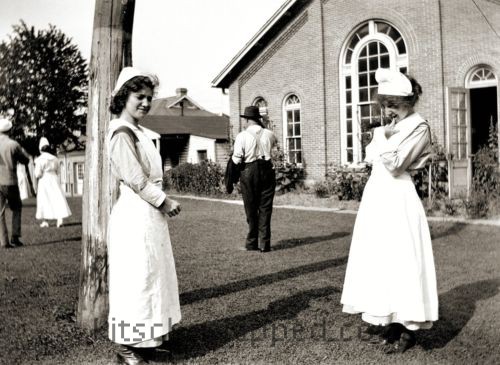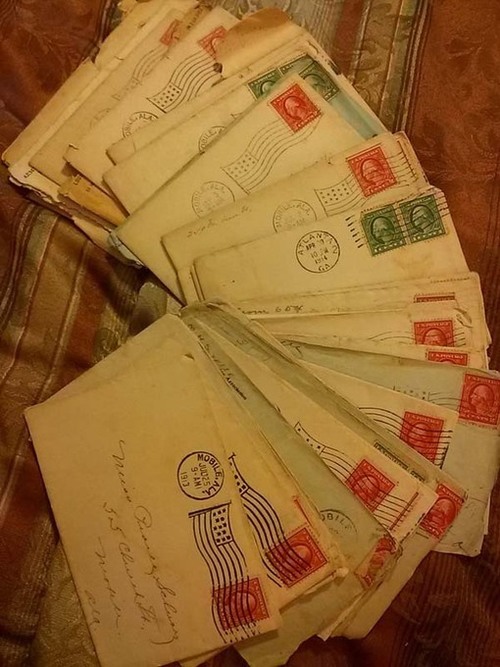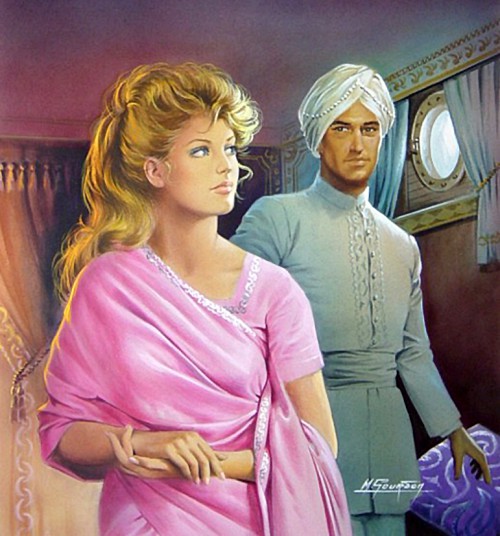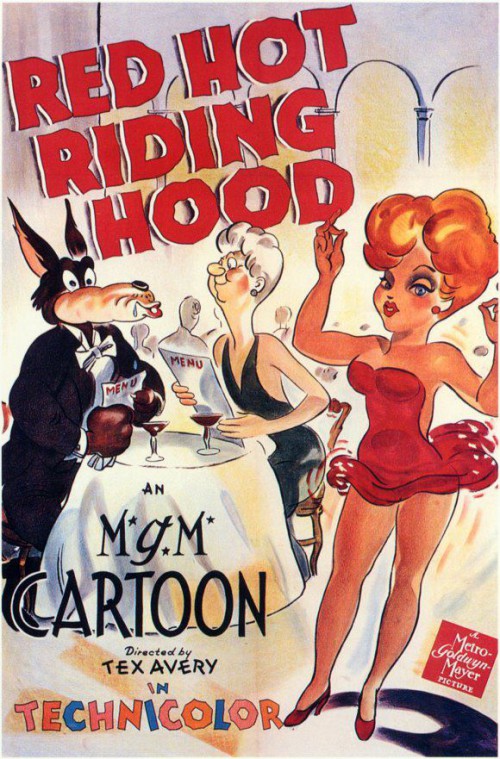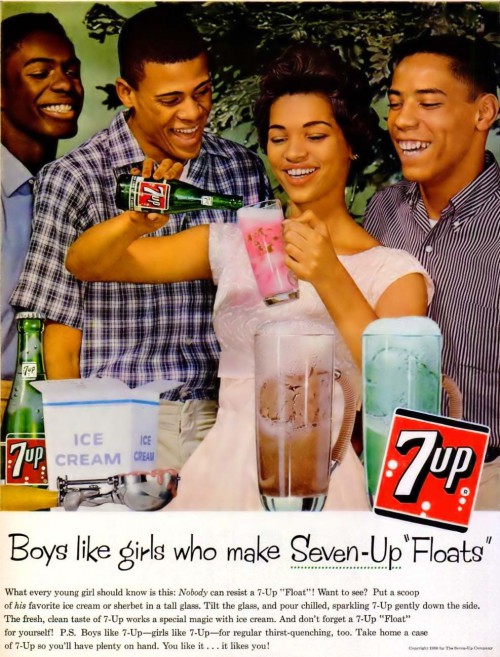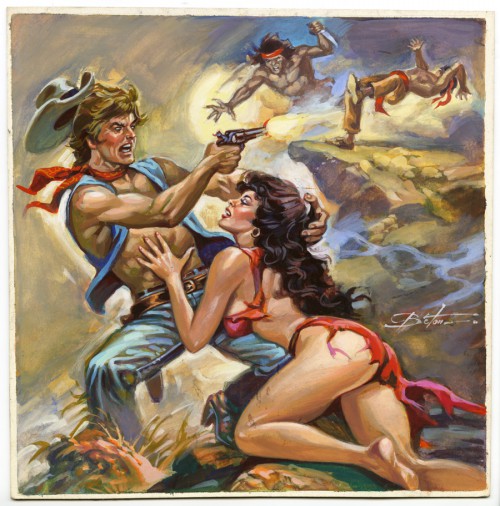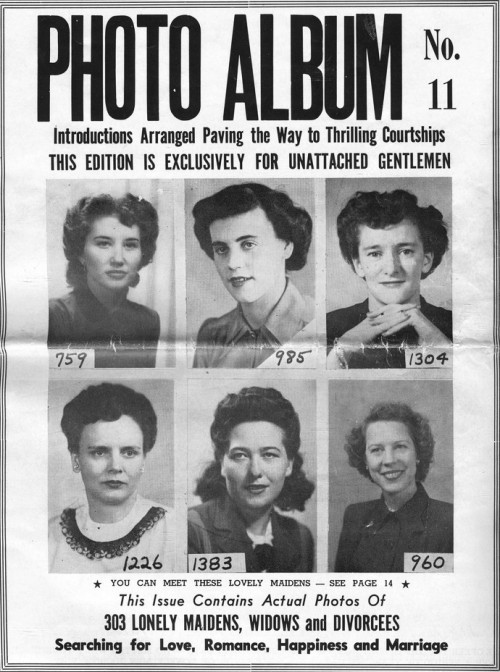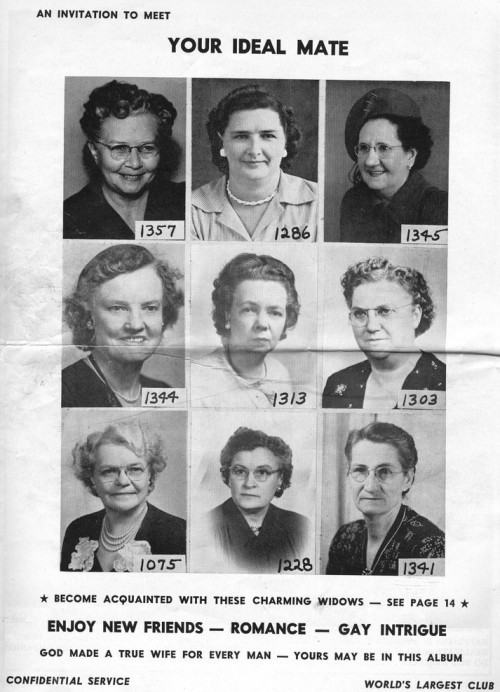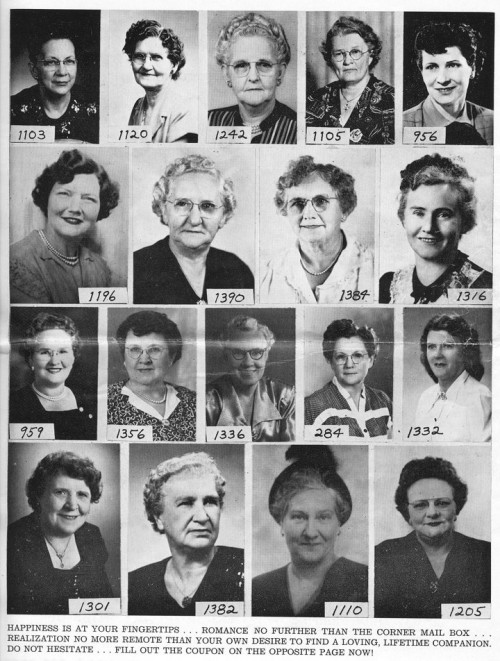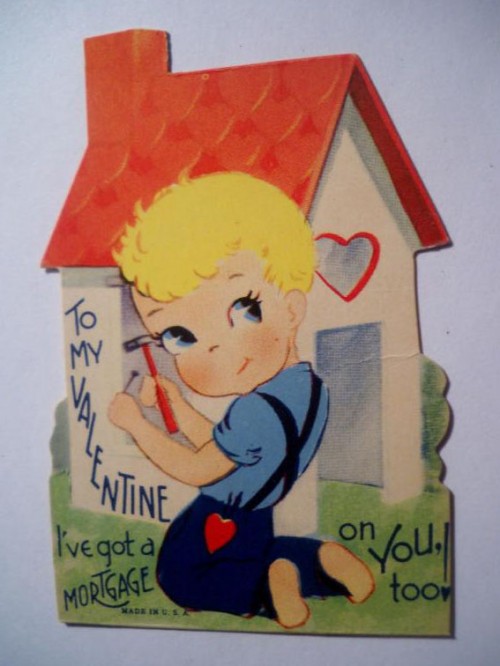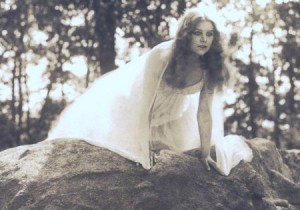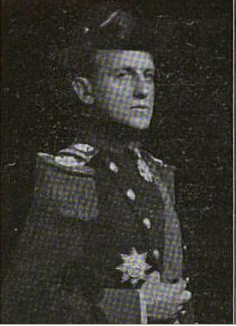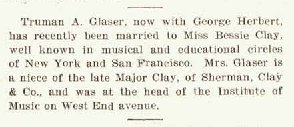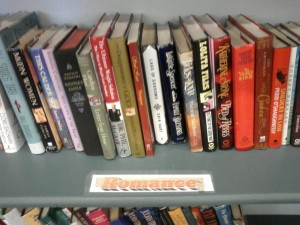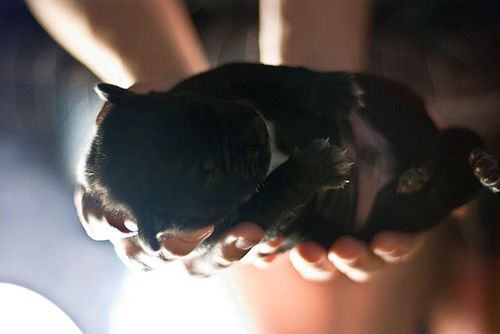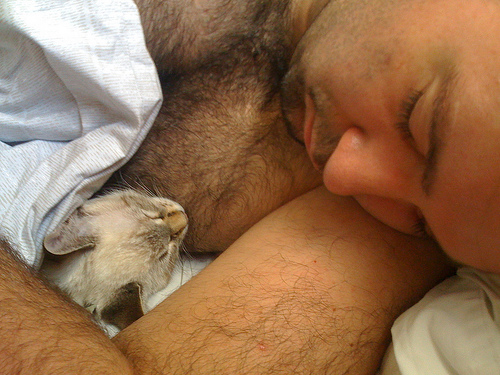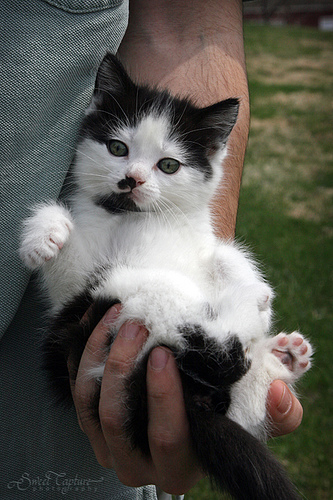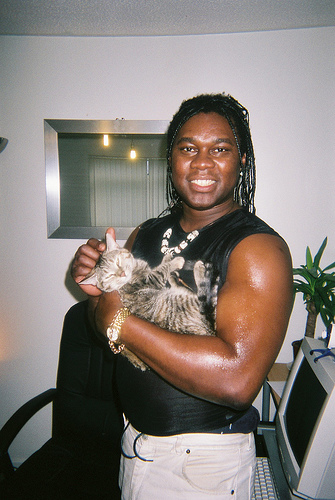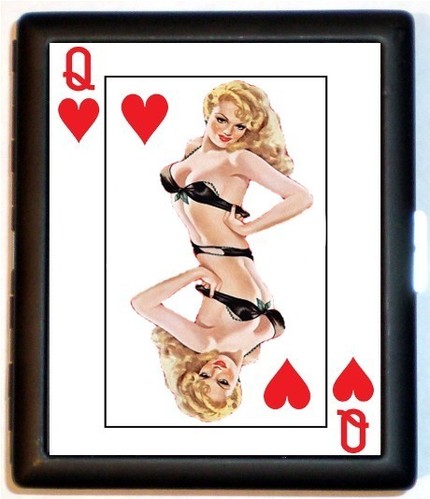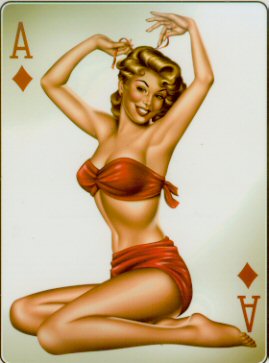Photo circa 1920s.
Tag: romance
In 1913, She Told Him They Couldn’t Be Together. 100 Years Later, THIS Was Just Discovered.
While searching through the attic of his father’s house, a son came across boxes of old items. The most interesting were piles of love letters sent from a man named Max. From 1913-1978, Max and Pearle wrote each other. All his letters begin with “My Sweet Pearle” and end with “Forever yours, Max”. These letters were supposed to have been burned when Pearle passed away in 1980, but the family didn’t honor those wishes, and one of the greatest love stories began to unfold.
In 1911, a woman named Pearle Schwarz met a man named Maxwell Savelle at the Country Club. They fell madly in love. Unfortunately, Maxwell would not convert to Judaism (his parents were Southern Baptists) and so they could not be together. They went their separate ways – Maxwell went into the Navy and Pearle continued to pine for him until she died. She never let go.
See on www.viralnova.com
I Forget…
Is the blonde Barbie-esque babe with the rich Arab sheik on the cover of this vintage pulp romance novel a gold digger or just plain racist? Both? Vintage book cover art by Michel Gourdon.
Turning The Tables On Fairy Tales With Red Hot Riding Hood
Tex Avery’s Red Hot Riding Hood (MGM, 1943) turns many tables — but not enough — on old stereotypes:
http://www.youtube.com/watch?v=NYGs0ADFX7w
The most famous element is the musical scene where Red performs and “Wolfie”, as she calls him, reacts in highly lustful wild takes. Those reactions were considered so energetic that the censors at the time demanded cuts in this scene and others.
The film’s original conclusion had Grandma marrying the wolf at a shotgun wedding (with a caricature of Tex Avery as the Justice of the Peace who marries them), and having the unhappy couple and their half-human half-wolf children attend Red’s show[citation needed]. This ending, deleted for reasons of implied bestiality and how it made light of marriage (something that was considered taboo back in the days of the Hays Office Code), was replaced with one (that, ironically, has also been edited, but only on television) where The Wolf is back at the nightclub and tells the audience that he’s through with chasing women and if he ever even looks at a woman again, he’s going to kill himself. When Red soon appears onstage to perform again, the Wolf takes out two pistols and blasts himself in the head. The Wolf then drops dead, but his ghost appears and begins to howl and whistle at Red same as before.
Prints with the original ending (where the Wolf is forced to marry the lusty Grandma) and the Wolf’s racier reactions to Red are rumored to have been shown to military audiences overseas during World War II, though it is not known if this print still exists.
‘Cuz suicide is funny. Or at least suicide, like most violence, is preferable to sex.
And in on of the weirdest decisions regarding bestiality ever, it’s only offensive if the woman is older — and lusty.
What Every Young Girl Should Know
Boys like girls who make Seven-Up “Floats”
What every young girl should know is this: Nobody can resist a 7-Up “Float”! Want to see? Put a scoop of his favorite ice cream of sherbet in a tall glass. Tilt the glass, and pour chilled, sparking 7-Up gently down the side. The fresh, clean taste of 7-Up works a special magic with ice cream. And don’t forget a 7-Up “Float” for yourself! P.S. Boys like 7-Up — girls like 7-Up — for regular thirst-quenching, too. Take home a case of 7-Up so you’ll have plenty on hand. You like…it likes you!
Hey, look, it may be sexist, but it also tells girls how to avoid giving boys head — on their 7-Up “Floats” (forever in quotes) and later, their beers.
Copyright 1960 by the Seven-Up Company; via.
Savage Me In The West
A further proof of my “Western’s are male romance novels” theory, I present Sexy Girl Cowboy, gouache artwork by Betoll, created as the cover for a Micro Mystery #173 (circa 1970s). At least everyone — from white cowgirl and cowboy to Native Americans — is at least a sexual savage. And I’ll be kind and not talk about his premature gun ejaculation. Via Grapefruit Moon Gallery.
Sentimental And Funny (Because It’s True)
Valentine’s Day is over, but there’s no reason you can’t send this as one of those “just because” greetings…
Once Upon A Time… Mail Order Girlfriends
Found at Chateau Thombeau, a lovely look at these pages from Photo Album No. 11, apparently a vintage dating help publication featuring “lonely maidens, widows and divorcees searching for love, romance, happiness and marriage.”
(And don’t those little numbers remind you of criminal booking photos?)
Without seeing the actual publication, it’s hard to say for certain, but it looks as if the “happiness at your fingertips” is based solely on the male reader’s reaction to a photo.
I don’t mean to be cruel or sexist, but if that’s the case, some of these women would only find happiness at their own fingertips; those grimaces are extremely unfortunate. But if they knew how to physically pleasure themselves, they probably wouldn’t have those frowns in the first place. Or probably care to be a mail order girlfriend or bride.
Yes, chemistry is important; but even Playboy has the model’s bio bit. Seems personality was even less important in this vintage mail order girlfriend magazine than in the fantasy fodder pages of men’s mags. Guessing from the photos, this wasn’t that long before Playboy would hit the stands.
I’m surprised head-shots alone were used. Even for the younger gals. How was a guy supposed to check out her breeding hips?
I suppose we should be thankful that this edition is “exclusively for unattached gentlemen.” …But then real gentlemen aren’t the ones to worry about.
And “this edition” is exclusive? That sort of begs the question about other issues…
Help For The Gold Diggers Of Victorian Times
A rundown of Victorian Atchison’s most eligible bachelors, as published in The Atchison Globe, January 6, 1885. Via Ye Olde News, a Tumblr site that actually does document where stuff comes from. (Yes, I Tumbl(r) from time-to-time.)
Ah, I love tracking old romance in newspapers — a la the Von Dewitz twits.
“To My Valentine I’ve got a Mortgage on you, too!”
Ah, yes, another reminder that women belong to men; we are so much their property, that you can woo them with that fact on a Valentine. (Vintage Valentine via kimmly.
Ranch Romances & Adventures
Ranch Romances & Adventures, May, 1971.
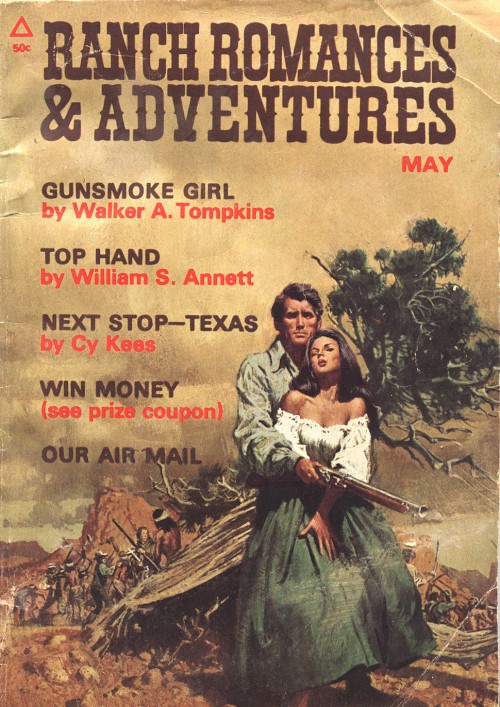
Contrary to what Jack Martin/Gary Dobbs says, I do not see Ranch Romance (& Adventures) magazines as primarily for women.
Jack/Gary says they must be “aimed at young women since all of the stories have a romantic element to them.” But come on now, dude, I know this may be difficult for a man who loves Westerns to admit but the whole genre – from books to films — is nothing but male romance novels and dick flicks. Sure, there’s some action in there; but the guns and body counts are there to win the damsel, the dame — the 500 miles he would walk just to fall down at her door.
Stop living in denial.
You men are just as much suckers for romance as we women are. You want to read about a good chaste kiss, a ravishing bodice ripping — and this publication proves it.
Or does it… Perhaps I am biased more than a bit by my feminine experiences and feminist equality-seeking nature. For over at Laurie’s Wild West, Laurie Powers shares the story behind the pulp magazine, using the publication founder’s own words. Harold Hersey claimed full credit for launching Ranch Romances in September 1924 (The “Adventures” joined the “Ranch Romances” in 1969) in his biography, Pulpwood Editor. Hersey writes:
My home run was Ranch Romances. I conceived of the idea of combining the Western and the love themes in a single magazine under the title of Western Love Stories. Our distributors considered it too close an imitation of the Street & Smith titles. We were told to think up another. The result was Ranch Romances and it was an almost instantaneous hit with women readers. Instead of the cowboy hero, we offered the cowgirl heroine. Bina Flynn, the editor we chose to handle the fresh idea, built the magazine into a huge success.
While I think combining Westerns and Romances is redundant, either I’m wrong — or Hersey’s another one of these men afraid to admit the romantic truth about men. Maybe, just maybe, the truth of Ranch Romances‘ success lies in the complicated truth of this simple line: “Instead of the cowboy hero, we offered the cowgirl heroine.”
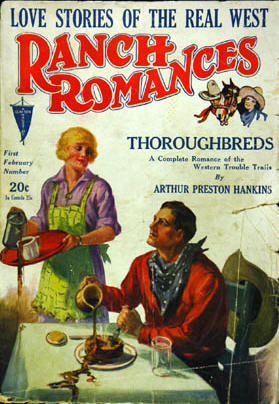
Women likely responded to dreaming the possible dream of a strong female heroine who was still desired by men. Men likely felt reciprocally reassured that even today’s ballsy woman still could be wooed and won by a macho male. (However, as always, the stories end before the truly difficult part of meshing roles and living happily ever after begins; like dirty dishes in the sink, no one wants to get to that part.)
Laurie Powers touches on some of this modernized gender stuff in her post too, so read that as Exhibit A. And as further proof of the male adoption of this publication I’ll let you know that the previous owner of my May 1971 issue was male. And check out the sexist ad on the back cover.
Anyway, this Ranch Romances & Adventures I have makes me sad. (It probably made others sad too as it was the publication’s last year.)
Ranch Romances may have been more of a pulp publication, prior to the mid-1960s at least, with fantastic graphics and fantasy fiction, but by this point the magazine was more personals ads digest than pulpy delight.
Of course, I may be biased. Again. I prefer the vintage styles more than the retro ones, and my “like” barometer is built upon that grading system. But from what I’ve seen and read, Rance Romances & Adventures is a desperate combination of personal pleas and ads designed to make money off those in despair.
(I’ll be sharing more of scans from this particular issue here and over at Kitschy Kitschy Coo as Valentine’s Day approaches.)
If You’re Lonely & Wistful This Valentine’s Day…
 If the holiday of romance has you looking backwards, remembering a love you once had, a first love, instead of celebrating a romance of today or eagerly looking for the romance of the future, I ask you to limit your indulgent trip down memory lane to just this one day…
If the holiday of romance has you looking backwards, remembering a love you once had, a first love, instead of celebrating a romance of today or eagerly looking for the romance of the future, I ask you to limit your indulgent trip down memory lane to just this one day…
Anything longer, anything more than a fond remembrance over a carton of ice cream (shedding of tears optional) is putting your romantic future at risk.
See, we have this tendency to remember the relationships of the past through rose-colored glasses or an emotional layer of sepia tones, glossing over the reasons why it didn’t work out. And the further away in time those relationships were, the worse it gets.
Like the cultural recalling of the “good old days,” we tend to forget that those easy-peasy, lemon-squeezey relationships of yesteryear seem so easy largely because we were younger, our problems smaller. Especially when seen with the older & wiser (and somewhat world-weary) eyes of today.
But the danger of living even remotely in past romance isn’t just that we might be missing the moments of today; it’s that we are seeking simpler times, simpler relationships, setting up unrealistic standards for the relationships of tomorrow.
So feel free to enjoy or even wallow in the romantic past for the day. A day. But don’t try to live there.
Or you won’t ever be happy where you are now.
Image via Since She Left.
Oh, Those Von Dewitz Characters
Because I become obsessed with research, especially when so little is readily available…
In doing some additional research for a piece on silent film star Valda Valkyrien…
I found juicy tidbits on her first husband, Baron Hrolf von Dewitz.
From The New York Times on September 7, 1919:
Special to The New York Times
GREENWHICH, Conn., Sept. 6.– A man calling himself Baron Hrolf J. O. E. Dewitz of New York, a moving picture director, and a girl who said she was A. M. Thaisn de Malmey, a moving picture actress, and daughter of Joseph W. de Malmey and Catherine Thomas de Malmey, were married today by Justice Albert S. Mead in his office. They came up by train from New York, and the bride changed from a traveling dress into a gorgeous pink creation for the ceremony and back again afterward into her traveling costume. Dewitz gave his age as 40, and said he was born in Denmark, and Miss de Melmey gave hers as 21, and said she was born in Spain and was a cousin of the late Empress Elizabeth of Austria. They said they had never been married before. They left for New York, saying they would leave New York Sunday morning for the Pacific Coast.The so-called “Baron” Dewitz, in spire of his statements to the Greenwich Justice, has been married before, not only once, but several times, and his erstwhile wives are on record as divorcing him. Records show that on May 17, 1908, he was married to Nina Pastorelli, a toe dancer with “The Dancing Daisies.” On April 4, 1911 he married Mrs. Katheryn de Montford, an actress, who obtained a divorce from him on Jan. 18, 1912. His third venture was with Miss Freed, whose stage name was Mlle. Valkyrien, another dancer, who as Mrs. Adele Freed von Dewitz also got a divorce, the interloculory decree having been signed on Feb. 13, 1919, by Justice Albert F. Seeger at White Plains. She was then in the movies, and the decree gave her the two-year-old son of the pair.
At the time he married Miss Freed, otherwise Mlle. Valkyrien, the “Baron” sent out cards announcing that their residence would be at the Plaza after Sept. 1, 1914, but at the time the cards were issued he and his bride were living at 560 West End Avenue with a Miss Bessie M. Clay.
So far, I’ve not found anything substantive about the earlier Baronesses von Dewitz (and you know I’ll keep looking — The Dancing Daisies?! Oh. My. Gawd.).
 But I did then find a lengthy wedding notice, also in The New York Times, dated June 23, 1914. (I’m so going to interject along the way for this one.)
But I did then find a lengthy wedding notice, also in The New York Times, dated June 23, 1914. (I’m so going to interject along the way for this one.)
Cards bearing the imprint of a jewelry house and the baronial crest of a noble Danish family were sent through the mails yesterday to well-known New Yorkers, saying that:
Lo Lieutenant Baron Hrolf von Dewitz,
et Mademoiselle
Valkyrien Freed de Copenhaque
ont l’honneur de vous
announcer leur mariage en date du
quatorze Mai, a L’eglise
Evangelicale-Lutherienne de Saint Mathieu
a Jersey City
Don’t you just love “Jersey” tacked on the end of all that French — and when, for that matter, did Valkyrien become French?
A second card states, also in French, that the Baron and Baroness would be at home at the Hotel Plaza after Sept. 1.
Baron von Dewitz, whose marriage on May 14 in Jersey City is thus announced, is the same Baron who on April 4, 1911, married Mrs. Kathryn de Montford, an actress, at Stamford, Conn., and who, several years previously was reported married to Nina Pastorelli, a toe dancer. Although the alleged marriage with Miss Pastorelli was extensively published in the newspapers, it was shown later that the wedding did not take place.
The matter of being shown that the marriage to Miss Pastorelli did not take place is A) not as reported later, and #2, not really shown at all.
In his most recent matrimonial venture Baron Dewitz again went to the stage for a wife, for Mlle. Valkyrien Freed is a dancer and a member of the ballet of the Royal Theatre in Copenhagen. Furthermore she is about to embark upon a professional career in this country despite her title, and at a dinner tonight at the home of Miss Jeannette L. Gilder, the writer, her stage future is to be talked over by her husband, Miss Gilder, who, through taking the management of another dancer has become an enthusiastic impresario, and the Baroness herself.
Please note the Baron’s involvement in his wife’s career; there is more flavor to savor later.
Although the wedding announcement cards say that the Baron and Baroness will be at home at the Plaza after Sept. 1, they are at present living at the home of Miss Bessie M. Clay, at 560 West End Avenue. It was explained last night by Baron Dewitz that this was because he and his bride wished to live in seclusion for a while, and at the same time it gave the Baroness an opportunity to practice her toe dancing.
The Miss Bessie M. Clay mentioned is likely the then President of The New York Institute of Music, located on West End Ave.; more on her, and why they would live with her, is here.
The marriage of Baron Dewitz and the toe dancer, who is not yet 19 years of age and who is a young woman of remarkable beauty, ends all the chances the Baron had of coming into a great estate and another title, he said last night. In fact, he is likey to be cut off by his relatives altogether for not returning to Copenhagen and marrying into a royal family.
“This wedding with Miss Freed,” said the Baron last night, “was a real romance. Two years ago when I was at home I met her and we fell in love. I returned to this country and we wrote each other frequently, but my family, and hers, too, put so many obstacles in our path that we gradually stopped writing. Last month we decided to marry after all, and so she came to this country. I met her at the boar and took her to the home of a married sister in Jersey, and a week later we were quietly married.
Put a pin in that “met two years ago” part — there will be some math.
“We are going to Newport in a short while, and she may give some exhibition dances there. I have been approached with offers to to upon the stage, but I am told that in this country a man who goes on the stage is not likely to be taken seriously in business affairs afterward. In my country I could go on the stage as a lark and nothing would be thought of it.
Remember when I asked you to note the Baron’s involvement with his latest wife’s performance career? Well, it sure seems to me that the Baron von Dewitz desperately wants a stage career himself. He’s willing to give up his title and wealth for it. And remember that first (though more recent) article wherein he calls himself “a moving picture director” — I guess that line’s a winner.
“The report that I have been married several times is all a mistake. I knew Miss Pastorelli when I was here some years ago and was seen about with her frequently. Some months after I had left this country I was surprised to get some old newspaper clippings saying that Miss Pastorelli and I were married. It was so long after the time that the stories had been published that I did nothing at all about it. I was divorced from Mrs. de Montford about a year and a half ago.”
But remember, the later clipping states that “records show” his marriage to Pastorelli on May 17, 1908. “Records,” not “reports.”
And remember, you have a pin in the number two, right? Do the math with his statement that he “was divorced from Mrs. de Montford about a year and a half ago.” Erm.
Baron Dewitz, who writes for the magazines, was a Danish naval officer who was one of the first to take up aeroplanes as war machines, and for some time was interested in perfecting air warship which he wished to sell to European Governments. He said last night that the cost of the enterprise was so heavy that he finally dropped it.
Baron Dewitz apparently did write, including a book titled War’s New Weapons.
At least that much is true.
*About Miss Bessie M. Clay and The New York Institute of Music: A bit from The New York Times, October 22, 1905:
An interesting feature of this college is what is known as the “Home Department.” As more and more girls have been coming from places far from New York to study music, there has been a growing demand for their proper accommodation in the city. Accordingly it is now possible to obtain not only musical instruction at the institute, but rooms, board, and chaperonage can be secured. But the care of the visitor does not stop here. Informal teas and receptions will be arranged to which persons prominent in the musical and artistic world will be invited. There are classes in dancing and fencing, and there is also a bowling alley and gymnasium. In other words, a student from the West can secure here many of the advantages and pleasures she would find at a college like Wellesley or Vassar.
I believe this 1906 issue of Music Trade Review is also on Miss Bessie Clay (said to be the niece of Major Clay of Sherman, Clay & Co.) and her marriage to Truman A. Glaser.
However likely this seems to be the same Bessie Clay, I cannot account for the continued reference to her as “Miss Bessie” past 1906.
And that brings us to the end of today’s (last night’s) obsession. Until I find out more — or you add to the story with what you know.
Once again, I’d like to declare my deep abiding love of The New York Times for making their archives available.
Once Upon A Time… Gothic Romance Tales: Airs Above The Ground
Once upon a time, I read romances.
First of all, they were plentiful in my youth. Not only did the popular paperback novels go from house to house as the adults around me swapped and traded books, but one of my aunt’s neighbors worked for a mall bookstore and he often went (against rules of his employment) and raided the dumpster for the paperbacks which were dumped after the covers had been torn off and returned to the publishers for credit, sharing the free books with anyone who would show up to grab copes when he put out the call.
Second of all, when in junior high our family moved a few miles away from that home near extended family, I ended up at a new school. A shy bookish sort, I was sorely in need of a friend, so when befriended by a fellow reader, I tried to read what she did. And she read romances.
I quickly gave up her favored Harlequins and turned to the bit more complicated, less predictable, suspense and Gothic romance novel varieties. But the shared romance novel reading ended quickly — even before she stole my first boyfriend.
I can’t say that the devastating loss of “Skip” hasn’t tainted, by association, any appreciation of the romance genre (they are forever tied together in my mind), but I honestly had been bored and annoyed with romance novels prior to that tender teenage heartbreak experience. Really. When I was about eight, I had practically gone from horse stories to non-fiction, so I felt silly reading predictable sappy love stories.
Yet, whenever I’ve spotted a Mary Stewart or Phyllis A. Whitney novel, I must confess, I’ve felt a fondness…
At first I told myself that this was some simple sense of nostalgia, memories of early years happily reading at my grandparent’s house while the adults played cards combined with the remembrances of myself as an wistfully romantic girl. Such things would make romance novels seem comforting — like pulp versions of turkey pot pies. Yet there there seemed something more…
Something compelled me to remember these authors and their books favorably after all these years. If I was ever going to know the truth, my truth about these books, there was only one thing to do: give in, purchase a few, and read them.
 I selected Mary Stewart’s Airs Above The Ground to read first because I knew it was not one I had read before (surprising as the book boasts of the beautiful Lipizzan stallions I was so dreamy about as a youngster) and figured that would remove the potential of too much nostalgia.
I selected Mary Stewart’s Airs Above The Ground to read first because I knew it was not one I had read before (surprising as the book boasts of the beautiful Lipizzan stallions I was so dreamy about as a youngster) and figured that would remove the potential of too much nostalgia.
My copy is a 1970 printing (thrift store score for a dollar or less), but the work was copyrighted in 1965 (a year after I was born!) and that means there are some beguilingly sexist passages for a feminist reader like myself.
On page 216, “our young wife’s” husband asks her if she can manage the “hellish” walk that lies before them in the dark; this is our heroine’s response:
He was already leading the way at a good pace. The question, I gathered, had been no more than one of those charming concessions which make a woman’s life so much more interesting (I’ve always thought) than a man’s. In actual fact, Lewis invariably took it serenely for granted that I could and would do exactly what he expected of me, but it helps occasionally to be made to feel that it is little short of marvellous for anything so rare, so precious, and so fragile to compete with the tough world of men.
On page 219, along the “hellish” walk:
For me the night had held terror, relief, joy, and then a sort of keyed-up excitement; and drugged with this and sleepiness, and buoyed up by the intense relief and pleasure of Lewis’s company, I had been floating along in a kind of dream — apprehensive, yes, but no longer scared; nothing could happen to me when he was there. But with him, I now realized, it was more than this; more positive than this. It was not simply that as a man he wasn’t prey to my kind of physical weakness and fear, nor just that he had the end of an exacting job in sight. He was, quite positively, enjoying himself.
Another favorite, from page 234, about Timothy, the son of the friend of the family who accompanies her on this mystery adventure:
Something about his voice as he spoke made me shoot a glance at him. Not quite authority, not quite patronage, certainly not self-importance; but just the unmistakable echo of that man-to-woman way that even the nicest men adopt when they are letting a woman catch a glimpse of the edges of the Man’s World.
When one removes (or forgives) such things, as (or if) they can, and reads for the story itself, what remains?
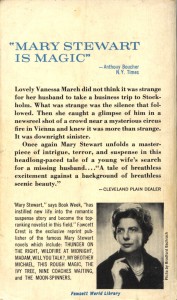 Officially billed as a “romantic suspense story” (presumably not officially labeled “Gothic romance” as it only has the air of the supernatural; there are more logical reasons for creepy mists and the seemingly impossible), Airs is not so much a will-he-ever-love-me romance as a is-my-man-a-dirty-rotten-creep mystery. This, of course, appeals to my jaded personality. So I quickly devoured the 255 pages, wondering if he is a creep, what his weak-arse story will be — and if Vanessa will fall for it (or, maybe, fall for the much younger Timothy?)
Officially billed as a “romantic suspense story” (presumably not officially labeled “Gothic romance” as it only has the air of the supernatural; there are more logical reasons for creepy mists and the seemingly impossible), Airs is not so much a will-he-ever-love-me romance as a is-my-man-a-dirty-rotten-creep mystery. This, of course, appeals to my jaded personality. So I quickly devoured the 255 pages, wondering if he is a creep, what his weak-arse story will be — and if Vanessa will fall for it (or, maybe, fall for the much younger Timothy?)
I won’t ruin the book for you with too many details or the outcomes. (However, I must tell you that the promised backdrop of Royal Lipizzan Stallions isn’t as rich and predominant as a horse-lover might like… But I’m supposed to have outgrown that romance too, right?) The bottom line is that Airs Above The Ground is, as far as expectations for a bit of romantic suspense fiction goes, pleasantly complicated enough not to be predictable.
It won’t win any awards from me; it is what it is. But I cannot disparage it. And maybe that means I ought not disparage the genre… A few more books will tell.
Whatjamacallit Wednesday: Lessons From Thrift Store Bookshelves
I know it’s a crappy photo (it’s beginning to be a habit), but at least you’ll believe me when I say that Dr. Phil’s Ultimate Weight Solution and Richard Elliott Friedman Disappearance of God were shelved as “Romance” in the thrift store. Sure, customers could have done it; but that’s no less amusing to me.
Romancing The Van: Ephemera Proves There’s Someone For Everyone
Two years ago, hubby and went to the junk yard to get replacement doors for our van, Ookla. I was utterly fascinated with the junk yard itself and was almost disappointed when we found the right doors — but the adventure wasn’t quite over yet…
I sat down inside the van, to get out of the hot sun, while Derek went about the business of removing the doors from the junked van; I looked about. Clearly the last owner’s belongings had not been cleared out of the vehicle. Paper and trash were strewn about, but then there it was — a Playboy magazine. Water-damaged and smelling of mildew, but there it was, right next to a bottle of Axe body spray. Does it get any more kitsch than that?!
(Now, before I go any further, you should know a bit more about when we went to purchase Ookla, our old conversion van. When the salesman unlocked the vehicle and showed us the spiffy airline lights which ran along the floor and the ceiling, the first thing I said was, “Hey, was porn made in this van?” Both the salesman and Derek blushed. So I’m neither a prude nor surprised that the previous owner of this van was also marked with smut — it just seemed to be a sign that along with make, model and year, these doors were the right match for dear old Ookla.)
But before I could reach for that Playboy, my eye spotted something else…
Yup, that there is a used tampon, folks.
I carefully reached for the Playboy. It was only the cover and badly damaged — but where there’s a cover… So I kept looking about, being very careful where I put any part of myself, least I find another tampon. Or worse.
Next, I spotted a notebook with a fancy silver foil cover. Only the first page was written on — a cheap attempt at fantasy fiction, with the main character discovering a magical notebook with a silver cover. (Yeah, I took that home for giggles later.)
I then found a bill for the van’s last oil change, paid for in 2005; been sitting here awhile, I guess.
I eventually found the insides of the Playboy and I put them with the magazine cover pages and the silver notebook just as Derek called for my help to hold the doors while he took out the last bolts.
I got out of the van, headed to the back. Standing there, just holding the doors, I scanned the insides of the van from this new angle. Immediately I note Star Wars light saber boxes — not one, but two of them. If the amateur sci-fi-slash-fantasy-fiction and Axe wasn’t proof enough of an under-sexed goober, the Star Wars weaponry was. This van was owned by a nerd. A nerd who, according to the oil change bill, had the first name of Jim.
Then I spy something else…
“Hey, Derek, what’s that by your foot?”
“Huh?”
“What’s that black thing by your foot?”
“I dunno. Let’s get this door off…”
We set the door down and I go to get a closer look at the black thing which was by his foot. It’s a bit of fabric… After the tampon, you’d think I’d be leery, but I had to know what it was, so I cautiously picked it up.
In my hand I then held one very small pair of black nylon panties, bikini style — with lots of lace. I should’ve dropped them like they were on fire, but they were very, very clean looking. I started laughing.
Oh my God, it looks like Jimmy had himself a woman. At least once. A light-saber-playing, small-black-panty-wearing, menstruating, Playboy-accepting woman who could tolerate the smell of Axe.
There’s someone for everyone.
My Summer of ’79
At 15, I was straddling the simple romantic fantasies of girlhood by day — and the hormonal induced sweaty-pink-bit-manipulations by night.
By day, I still played with Barbie & her friends. Still playing with Barbies was not something I advertised; I didn’t invite my girlfriends over to play with me. Like my nocturnal activities, this was the solo-play of self-discovery.
Playing with Barbie was like warm comfort food; I understood the rules and romance in playland, even if I didn’t understand the ways of the boys around me who had suddenly started reacting to my well-beyond-just-budding breasts.
But at night, I got hot and sweaty for Andy Gibb — via his posters on my walls.
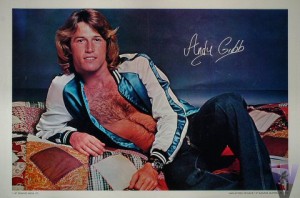 Especially that poster of Andy with his dark blue satin baseball jacket worn open to expose what I could only then (and now) best describe as a tree of hair — with a trunk that went down past the navel to what I could only then bear to imagine as another system of hair at the root… Leading to that something that beefed-up his tight satin pants. And that magnificent mane of hair on his head, ahhh... it still works.
Especially that poster of Andy with his dark blue satin baseball jacket worn open to expose what I could only then (and now) best describe as a tree of hair — with a trunk that went down past the navel to what I could only then bear to imagine as another system of hair at the root… Leading to that something that beefed-up his tight satin pants. And that magnificent mane of hair on his head, ahhh... it still works.
But before I begin to get lost in teenage masturbation fantasies, let’s just say that solo-play was far more productive in terms of my nighttime studies; learning the ins-and-outs of myself, physically & emotionally, was easier than figuring out interpersonal play by myself. But I did learn much about me.
At 15, I knew the score — or at least what scoring was — even if I wasn’t ready for it. At least not with a boy. If I was going to give in — and I wasn’t sure I was — it would be with a man who knew what he was doing.
Since I was an avid reader, Barbie wasn’t my only form of entertainment. (Nor was masturbation — quit trying to get me off the subject!) As an avid reader with a voracious appetite for books, my parents let me read freely from anything on the bookshelves at home and at the library. I hadn’t needed my parents’ permission for any reading material since what, I was 6, 7? I read what I wanted, and asked questions when I needed to.
For example, when I was about 10 I read a mystery book which presented a mystery it hadn’t intended. I forget the title and author, but the passage went like this: “and then he threw the flaming faggot into the fire.” Since the only definition for ‘faggot’ I knew was the same for ‘gay’ and ‘queer’ (hey folks, it was 1974, and folks were ‘out’ in theory even if I didn’t know anyone personally); I was at a loss. How could a man who was alone throw another man into a fire? And if there was someone around, why hadn’t he been mentioned earlier? Shouldn’t there have been some sort of exchange or motive? Was it just bad writing?
Book in hand, I approached my mother, showed her the passage and asked for help. How she kept a straight face (no pun intended) while explaining that ‘faggot’ was an English word for cigarette, I’ll never know… But I do know that not only had she helped me with my vocabulary but I helped her by letting her know what I knew. That’s what parenting is all about, yes?
So, flash forward five years to me at 15 again. I dragged myself away from Andy Gibb’s gaze, left Babs alone (that’s not a euphemism; I refer again to the classic fashion doll), and look for a book on my parents’ book shelf.
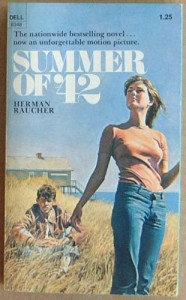 A title caught my eye, The Summer of ’42 — something about it was familiar. I remembered vaguely the book making news… Something about sex & banning the book… Hmm, I thought, I hope it’s not as dumb as Catcher in the Rye. (That book did nothing for me, sorry.) But curiosity won, and I took Summer of ’42 to my room and read it.
A title caught my eye, The Summer of ’42 — something about it was familiar. I remembered vaguely the book making news… Something about sex & banning the book… Hmm, I thought, I hope it’s not as dumb as Catcher in the Rye. (That book did nothing for me, sorry.) But curiosity won, and I took Summer of ’42 to my room and read it.
The book was well-written, but it was from the point of view of a boy, which I found faintly disinteresting. A group of boys who want to get laid, gee, that was news to a 15 year old girl with big boobs. But I hung with it (to date, I’ve only quit reading 3 books — I’m a girl who believes in commitment), and I learned a few things.
Like Hermie’s date with Aggie. Hermie thinks he’s getting lucky by touching her breast — a deformed breast lacking any nipple — only to discover later that he’d been fondling and groping her shoulder. (Hey, Andy Gibb would never, ever, have made that mistake!) This only confirmed my belief that boys were stupid. They were in such a rush, they missed pretty basic stuff. Idiots.
But at the end of the book, the cumulative lessons learned left me once again surprised: I’d read another banned book that left me wondering why it would need to be banned. Frankly, I still am.
Sure, Hermie (an under-age boy) has sex with an older (adult) woman; but it’s depressing. It’s not erotic. Nor is it abusive or crude. In fact, it scared me about my fantasies about Mr. Gibb. I mean Hermie was in love, head over heels in love — ga-ga — and after what he thinks is such a beautiful moment, this woman cries and leaves him. Sure, she was vulnerable with her husband’s death and all, but clearly, she didn’t want some kid. Ouch. And hey, Hermie’s got feelings! Who knew boys had feelings?
This was not some sex-filled-romp of adolescence. This was not some titillating erotic entertainment piece. This was heartbreaking. Even at 15, a never-been-kissed-by-a-boy girl, I recognized the agony of misplaced virginity. I knew that a first time, a first love, a first f***, was sacred. This wasn’t some fodder for a solo-f***-fest, some sensationalized erotic entertainment — far from it. It was a warning. Not only were young boys not practiced enough to find a boob, but they were immature enough to not know they should protect their hearts. While I felt that I would fare better in the groping department, I knew I was likely as lame in matters of the heart.
Not long after, Barbie was put away and didn’t see sunlight until we had a garage sale. I had mastered what I needed to know: romance was a fickle bitch, boys could indeed be hurt too, and romance could be as plastic — as one-sided — as a fashion doll.
I still masturbated to images of Andy, but I no longer romanticized meeting him after a concert and that he’d fall in love with me. It was just sex — just sex in my mind. And it was safer for me at that time to leave it at that. Too bad Hermie hadn’t been that self aware, hadn’t protected himself… And no wonder the older woman who should have known better, but was so affected by her own broken heart she couldn’t think straight, left town asap.
I grew up quite a bit reading Summer of ’42, and I likely saved myself some pain. I’m not saying I mad no mistakes; my life is a character-building exercise. But I made less mistakes, less painful ones. I have Herman Raucher to thank for that. And my parents — for they let me read.
Just last week I asked my mom if she knew that I had read Summer of ’42; yes, she had. I asked her if she was, well, creeped out by it. Her reply? “No. You always came to us if you had questions. …It was a sad story, wasn’t it?”
Yeah mom, it was sad. Sadder still to know that some kids weren’t allowed to read it. Thank you, mom and dad, for being good parents.
 Epilogue: Some kids and adults are still not allowed to read or view Summer of ’42 because it has been banned from their libraries. Or they’ve been told to avoid such ‘horrible’ works. I can’t speak for the film, but if you get a chance, read Summer of ’42. It might be too late to save yourself from past mistakes, but it’s never too late to learn something.
Epilogue: Some kids and adults are still not allowed to read or view Summer of ’42 because it has been banned from their libraries. Or they’ve been told to avoid such ‘horrible’ works. I can’t speak for the film, but if you get a chance, read Summer of ’42. It might be too late to save yourself from past mistakes, but it’s never too late to learn something.
Read it this week, Banned Books Week, buy Banned Books Week merch, blog about it and read what others have to say — and celebrate your freedom to read.
Interview With Nicole Zoltack
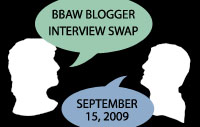 This week is Book Blogger Appreciation Week and festivities include today’s blogger interview swap, in which we were paired with another book loving blogger and (surprise!) interview one another. My interview partner is Nicole Zoltack is a medieval fantasy romance author, book reviewer for Long and Short of It Reviews and reviewer and editor for Dark Diva Reviews. (She’s posted her interview of me here.)
This week is Book Blogger Appreciation Week and festivities include today’s blogger interview swap, in which we were paired with another book loving blogger and (surprise!) interview one another. My interview partner is Nicole Zoltack is a medieval fantasy romance author, book reviewer for Long and Short of It Reviews and reviewer and editor for Dark Diva Reviews. (She’s posted her interview of me here.)
Nicole and I had never bumped into each other before; despite that, she was game to answer even the tough questions — including somethings you may have wanted to know, but were afraid to ask. *wink*
Please share a childhood memory that captures your joy of reading.
One book that I read repeatedly was called Tiffany the Disaster. I loved the title character. She was so pretty and got into a lot of trouble. Nothing seemed to faze her! I loved her so much that for awhile, in all my stories, the main female character’s name was Tiffany. You might think that means that if/when I have a little girl that I’ll name her Tiffany but no. I’m all Tiffany-ed out! But I’ll be sure to read her the story.
Nicole, has any adult situation compared to that first ‘falling in love’ with reading you experienced as a child?
Nothing truly compares to that first ‘falling in love with reading’ moment. I read as much as time allowed when I was a child. Now, with the responsibilities of being an adult, I don’t have anywhere near the amount of free time that I had to devote to reading. The best part of growing up and being a reader is that now that I’m an adult, I don’t get the faces from going to read the classics or other more adult books that I used to receive when I was younger. I love being able to read whatever book strikes my fancy, regardless of the subject matter or the genre. And I have more money to spend on books than I did as a child. So it balances itself out.
Has being an author changed your relationship with books? Do you view book reviews differently? Are you more critical when reading? Have your reading tastes changed?
Being an author has definitely changed by relationship with books. I often have to turn off my internal editor button so that I can enjoy what I’m reading instead of thinking, too much back story or too passive or too many adverbs. I am able to look at books at a different level, as a reader or as a writer. I can learn more from reading than I did before, what works, what doesn’t, how to incorporate back story into the story instead of just dumping information. I am definitely more critical but I still love to read and always will. My reading tastes haven’t changed as I’ll read anything. As for book reviews, I appreciate them more now as an author than when I was just a reader. I understand how much a review means to the author and since I am a reviewer myself, I look to other reviews when I want to buy another book.
Do you think the increase in popularity of romance & fantasy fiction, especially historical varieties, is symptomatic of a deeper desire to escape “today” and the stress in our lives?
I would agree that many people today want to escape from their problems in today’s world and turn to reading as an outlet and that’s reading in general, of any genre although romance is the biggest seller out of all the genres. Last year, romance fiction generated $1.37 billion in sales. When people need a break from stress, they need to find an outlet for that stress. What better way than to bury their nose in a book? Yes, the stories may have a fairy tale ending but an uplifting ending can make the reader happy and hopeful.
Some say that as a culture we’ve become delusional, dependent, upon the notion of romance & romantic fantasies in general (not specifically the genre of books, but other media, such as films); these people blame such fantasies for contributing to the high divorce rate. Not to make you the defender of all in your genre, but do you think there’s any truth to that? Why or why not?
This is a difficult question to answer and I’ll do my best.
I love romances. Obviously, or else I wouldn’t write them.
All forms of the media, from romance novels to movies to television, give the public a skewed idea and representation of love and relationships. Love is always idealized, prefect, pure.
It’s important for readers to keep from having unrealistic expectations concerning love and relationships. Books and movies are not like real life; we read or watch them to escape the real world. We read and see a fantasy. It’s fun and wonderful to read about Prince Charming but your boyfriend or husband is going to burp and do other things you really wished he wouldn’t. He’s not going to be romantic all the time. But that doesn’t mean that he doesn’t love you or that you aren’t in a good relationship.
You can’t sit around and wait for a prince to rescue you and whisk you away on a white horse. It isn’t going to happen, and you’ll experience heartbreak after heartbreak. No one is the perfect romance hero. But that doesn’t mean that you should just settle either. Wait for someone that makes you happy, not just warm and fuzzy inside. The warm fuzzes disappear after your hormones die down. Real relationships will have ups and downs and need communication, compromise, and hard work. Anything that’s worth having is worth fighting for.
You have to keep your expectations realistic. Hollywood and romance novels should an unrealistic ideal. But you can still have love and experience it. Only in a different fashion.
So people can enjoy the romantic ideal that is portrayal in movies and books so long as when the movie is over or they’ve finished the book, they know that their love not going to be as simple or easy as it was portrayed.
Just so you know, I think any subject/activity/food is fine; delusions, addictions, etc., whether chocolate, porn, or book genres, are a matter of moderation &/or mental state! But for those who eschew romance novels, give us a list of “classic romance fantasy” titles people should read before they form or state an opinion about the genre.
1. The Princess Bride by William Goldman
2. Anything by Tamora Pierce, especially her Lioness Quartet
3. Anything by Mercedes Lackey
4. Crown Duel by Sherwood Smith
Anything you’d like to add, Nicole?
If you think you might like a book, pick it up and read it. What do you have to lose? And who knows, it just might become your favorite book.
Thanks, Nicole!
When Nicole isn’t working on Knight of Glory, Book II in the Kingdom of Arnhem series and sequel to Woman of Honor, she spends time with her husband and adorable little son. Her love of everything medieval led to her having a Renaissance wedding and a ever-growing sword collection.
You can keep up with Nicole at her blog and via Twitter.
I’d also like to take a moment to alert BBAW folk to my New Vintage Reviews Carnival; if/when you review “old” books, please submit them to the carnival!
Divorce From Too Much Affection?
Romantic Pillow Talk – Of A Different Sort
Remember practicing kissing and caressing your pillow when you were a teen? Well, there’s a whole movement dedicated to romancing the pillow and other two-dimensional objects in Japan.
According to Lisa Katayama in the New York Times Magazine, there’s a fraction of men in Japan who adopt body-pillow girlfriends and other “2-D” lovers as a substitute for real relationships. These men take their pillow girlfriends out on dates to restaurants, to sing karaoke, to take photo-booth pictures — positioning their stuffed girlfriends gently, “making sure to keep her upright and not to touch her private parts.”
The guru of the 2-D love movement, Toru Honda, a 40-year-old man with a boyishly round face and puppy-dog eyes, has written half a dozen books advocating the 2-D lifestyle. A few years ago, Honda, a college dropout who worked a succession of jobs at video-game companies, began to use the Internet to urge otaku to stand with pride against good-looking men and women. His site generated enough buzz to earn him a publishing contract, and in 2005 he released a book condemning what he calls “romantic capitalism.” Honda argues that romance was marketed so excessively through B-movies, soap operas and novels during Japan’s economic bubble of the ’80s that it has become a commodity and its true value has been lost; romance is so tainted with social constructs that it can be bought by only good looks and money. According to Honda, somewhere along the way, decent men like himself lost interest in the notion entirely and turned to 2-D. “Pure love is completely gone in the real world,” Honda wrote. “As long as you train your imagination, a 2-D relationship is much more passionate than a 3-D one.” Honda insists that he’s advocating not prurience but a whole new kind of romance. If, as some researchers suggest, romantic love can be broken down into electrical impulses in the brain, then why not train the mind to simulate those signals while looking at an inanimate character?
Many single people here in the US might find some of this quite reflective of the culture here; only the display of physical substitutes for romance are less accepted here.
In Japan the fetishistic love for two-dimensional characters is enough of a phenomenon to have earned its own slang word, moe, homonymous with the Japanese words for “burning” or “budding.” In an ideal moe relationship, a man frees himself from the expectations of an ordinary human relationship and expresses his passion for a chosen character, without fear of being judged or rejected.
“It’s enlightenment training,” Takuro Morinaga, one of Japan’s leading behavioral economists, told me. “It’s like becoming a Buddha.” According to Morinaga, every male otaku can be classified on a moe scale. “On one end, you have the normal guy, who has no interest in anime characters and only likes human women,” he explained. “The opposite end, of course, is the hard-core 2-D lover.” Morinaga, a self-described otaku, didn’t have much luck with women until he became a well-regarded economist. Now he has a wife and a private office in a fancy apartment building near ritzy Tokyo Bay. “I’m a 2 — I still like human women better,” he said, a wide grin forming. “But there are many men who are on the opposite side of the scale. I understand their feelings completely. These guys don’t want to push ahead in society; they just want to create their own little flower-bed world and live there peacefully.”
Aside from the large scale physical display & touching, is this any different than the romantic fantasy of soap operas, romance novels, films like Twilight, etc.? I don’t think so. Retreating to a fantasy, love doll, pillow, erotic story ,or dreaming of your own vampire lover is just as sane — or insane, I guess.
Can any be replacements for real human relationships? Can Twilght fandom, eating chocolate, or profuse shopping be as emotionally satisfying as dating? Can rapid page turning of bodice rippers, caressing of printed pillows, or vibrators be as satisfying as real human contact?
Maybe not; but as long as you can tell the difference, know reality from fantasy, they can’t hurt you as badly as divorces, break-ups and rejections either.
That said…
I am creeped-out by the Japanese penchant for underage girls. Most of the Anime characters & other pillow girls seem to be pre-teen & teenage school girls. While that’s disturbing & debatable on it’s own, I don’t find anything wrong with the idea of pillows or 2-D romance per se.
…It’s a bit sad, but no sadder than the girl who buries her nose in a succession of Harlequin romances, downs her emotions in vats of chocolate, etc.
Got Love Boat Stories?
To celebrate National Romance Week, Princess Cruises has joined with Cruise Critic to conduct a search for real-life love stories that have taken place on the decks of Princess ships; Deanna just wants to impress Captain Stubing. *wink*
This (quick) post is part of the blogathon for Hope For Healing, raising money for & awareness of domestic violence; use this special link to iSearch.iGive.com — clicking it and performing searches will raise money for HopeForHealing.Org.
It’s National Romance Week
National Romance Week was established in 1995 by Michael Webb. Set the second full week in August, it’s six moth opposite to Valentine’s Day is by design because Webb intended this week to celebrate romance by focusing on people & relationships — spending time and attention, not money on “things” &/or events, like going out to fancy dinners.
Webb, who does sell romance on his websites, says, “Real romance comes from the heart, not the wallet” — but he does offer free tips, including a free 101 Romantic Ideas ebook to those who subscribe to his free newsletters. So, if you’re stuck for “things to do that show you care,” you can get the generic commonsense tips & give ’em a try.
In this economy, who couldn’t use a reminder that love & romance & need not have a price tag?
My advice, however, is to begin by doing as Web says and focus on the person in your life and think about what pleases him or her specifically. You know, those wishes & requests they make everyday…
From “more sex” to “pick up your socks,” from saying “yes” to the request for a back massage to saying “no” to another invite to dinner during an already busy week, from “put the toilet seat down” to picking the kids up (from the mall, soccer practice, etc.), from letting her have the remote to not acting so remote…
Huh, maybe I should write 101 tips book. *wink*
Secret Recipes for the Modern Wife – Exposed!
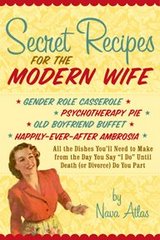 In contrast to the many products inspired by or incorporating vintage & retro images of female domesticity that only really offer humor, Secret Recipes for the Modern Wife: All the Dishes You’ll Need to Make from the Day You Say “I Do” Until Death (or Divorce) Do You Part, by Nava Atlas, offers some wisdom with the chuckles.
In contrast to the many products inspired by or incorporating vintage & retro images of female domesticity that only really offer humor, Secret Recipes for the Modern Wife: All the Dishes You’ll Need to Make from the Day You Say “I Do” Until Death (or Divorce) Do You Part, by Nava Atlas, offers some wisdom with the chuckles.
It’s easy to take one look at this cookbook, flip through the pages and realize that most of the ingredients, like “1 economy-size can of everything you and your husband ever had in common, drained,” are not of the edible variety and so dismiss it as just another product cashing in on the retro style craze — but don’t! While it’s true, as the publisher claims, that Atlas “grills societal norms with gleeful relish,” it’s also true that this book offers recipes. But not just any recipes, but the secret kind…
Success recipes for love, marriage, parenting, divorce, reconciliation — survival.
Instead of offering only the too-true advice that heaping servings of humor are needed to survive marriage and children, there are excellent (sarcastic & snarky) reminders that good health includes a sound mind, free of self-delusion, self-denial, self-betrayal & self-sacrifice.
Atlas states in the book’s acknowledgments & credits that Secret Recipes For The Modern Wife began as a personal project, “a small, limited edition artist’s book” using dark humor as a cathartic release for friends who were divorcing or otherwise suffering from marital malaise; but Trish Todd, Atlas’ editor, saw beyond the divorce theme and helped the author & artist shape the book into something more well-balanced. It even ends on a hopeful note with “Happily-Ever-After Ambrosia.”
Secret Recipes For The Modern Wife, with its recipes like “Beans ‘n’ Weenies of Sexual Tension” (below – click to read larger version), “Soufflé of Fallen Expectations,” and “Old Boyfriend Buffet” may not be suitable fare for the entire family — but keeping a copy of this book tucked away for a private & spontaneous flip-through will be good for the whole family. After all, what wife &/or mother doesn’t need a little stress relief? And hidden reading episodes are certainly preferable to a furtive nips of liquor in a closet.
The What I Think You Should Know Relationship Round-Up
There’s a whole heck of a lot of good relationship stuff on Twolia; I thought, just in case you never leave Relationship Underarm Stick, that you should see some of it…
Twolia now has a new relationships blog where you can make your own post — sort of like a forum. It covers not only dating & marital relationships, but friendships & relationships with family members & coworkers as well. Go check it out.
Over at Kitsch-Slapped, Deanna’s done the research on a sad story of romantic misfortunes that took place in the late 1940’s.
Deb Amlen (her book, It’s Not PMS, It’s You is due Spring 2010 from Sterling) has answered a letter about sleeping with your professor over at Miss In Your Business.
Survived all your relationship stink, and now you’re getting married? Congrats! Now see what you need for your wedding over in the Twolia Shops.
Married, single, divorced, whatever your situation, music tells your story. You know… Without breaking up and making up, there might be no music… So check out the music on Twolia — I’m digging Bri Anne Michelle and Ellee Ven’s Dangerous Diversion. (Yes, I can enjoy pop-country & hip hop too; how about you?)
Now It’s Really The Last Laugh
As usual, a tiny snippet in a vintage magazine drives me to obsessive research…
This time it’s a few lines on page 47 of Quick (November 21, 1949 — which had that feature on Esther Williams). The few lines, titled Last Laugh, are about the widowed singer, Mrs. Reseda Corrigan, who after having fallen prey to infamous bigamist Sigmund Engel, announced her plans for both a vaudeville act “showing how Engel made love to her” and her engagement to “booking agent and bandsman,” Al Turk.
Apparently it is worth noting that Mrs. Corrigan was not only a window, mother of three, and a singer, but a redhead — and her fashions were greatly detailed in the press reports of the court trials. I love how women’s fashions pertain to courtroom drama. Not.
Sigmund Z. Engel, was a real charmer. He’s credited with saying, “The age of a woman doesn’t mean a thing. The best tunes are played on the oldest fiddles.” And he apparently offered the press advice upon entering prison:
1. Always look for the widows. Less complications.
2. Establish your own background as one of wealth and culture.
3. Make friends with the entire family.
4. Send a woman frequent bouquets. Roses, never orchids.
5. Don’t ask for money. Make her suggest lending it to you.
6. Be attentive at all times.
7. Be gentle and ardent.
8. Always be a perfect gentleman. Subordinate sex.
Engel also wrote a book, titled Lover of 1001 Women — a copy of which currently eludes me. But I have heart. I always have heart when it comes to collecting; but love can be far trickier… As Mrs. Corrigan herself warned in the St. Petersburg Times, June 23, 1949, “When a man uses excellent English, whispers ‘I love you’ while at the same time kissing your ear, beware.”
It’s important to note that Mrs. Corrigan was not just bigamist-bitter, nor even money-taking-bigamis-bitter, but royally-pissed-bitter. This because during Engel & Corrigan’s engagement Engel went missing for a week. Then he suddenly called and asked Corrigan to take the first train out of Chicago and meet him in New York’s Grand Central Station. Corrigan complied. Not only was Engel a no-show, but, because Engel was supposedly wealthy, she arrived without any money of her own and was forced to live in Grand Central Station for eight days — sleeping in the washrooms and on public benches.
That would leave a bitter aftertaste all its own, yes? This is when she filed charges in Chicago, resulting in Engle’s photograph being published & the ensuing suits.
So we can understand Corrigan’s boasting in the press about her show and upcoming nuptials.
But Corrigan wasn’t to have the last laugh as far as I can see.
In the St. Petersburg Times, November 20, 1949, the following bad news:
Mrs. Reseda Corrigan’s “kissless romance” with band leader Al Turn is one the rocks — right where the vocalist was left by Sigmund (Sad Sam) Engel when he dashed off with her $8,700.
Soon after Engel’s conviction in Chicago, Mrs. Corrigan, 39, disclosed plans to marry Turk. But Turk said yesterday the whole thing was washed up. He explained: “She does a fair job of singing but she needs a log of training.”
Mrs. Corrigan was caught off base by Turk’s announcement but fired back: “I have more finesse than he has. He has no gallantry about him. Why, he didn’t even kiss me.”
Neither did Engel, she insisted, because “I’m a singer and I don’t want to be going around with germs in my throat.”
I’ve got a little something in my throat… I think it’s bile.
If anyone knows anything more about Reseda Corrigan, I’d love to hear about it — especially if you have a photo!
Cinderella Nurse: Masochistic Nurse Story Disguised As “Modern Romance” Circa 1960s
While nurses, like secretaries, may have been grudgingly accepted as appropriate occupations for women, the stereotypes about them were dangerously fed to men & women alike. And books like Cinderella Nurse by Jane Converse only helped the sexist notions.
 This retro paperback novel, published in 1967, was part of not only A Signet Nurse Book series, but part of a very long line of nurse novels, mostly designed to make girls (and women) moon-eyed over the career — not for its noble work in healing, not for its healthy paycheck, but for its lucrative lure of marrying a rich male doctor. As such, Cinderella Nurse has a cast of comic (yet infuriating) characters — which were supposed to be serious lessons regarding society’s moral compass.
This retro paperback novel, published in 1967, was part of not only A Signet Nurse Book series, but part of a very long line of nurse novels, mostly designed to make girls (and women) moon-eyed over the career — not for its noble work in healing, not for its healthy paycheck, but for its lucrative lure of marrying a rich male doctor. As such, Cinderella Nurse has a cast of comic (yet infuriating) characters — which were supposed to be serious lessons regarding society’s moral compass.
Before we get to our heroine, Rita Ambler, there’s her “eccentric” mom who finds “her answers in the cards” and other things “occult” — on Rita’s salary. And Rita’s “beautiful” sister, Nadine, who “can’t say no” (to anything but responsibility and nursing school) and yet the spoiled brat has devious plans…
At work, Rita’s supportive female cast includes Head Nurse Eloise Carrington, nicknamed “Giggles” because, of course, she is anything-but. “Giggles” is the old maid who has foolishly spent her life dedicated to healing — and the love-from-afar of a doctor she can never have (one who mocks “Giggles” & pursues our nurse Rita as well).
Rita doesn’t have a BFF, but the only friendly associate at work (or anywhere else) and therefore can loosely be called a “gal pal,” is nurse Connie Howell. Nurse Connie is a slutty but harmless-because-she’s-a-comical-hoot-of-a-cougar — as well as a good dedicated professional. But when Connie has a career high in which she assists in an operation — “not as a scrub nurse, as an operator” — she proves she’s at the hospital to go from RN to MRS and marry herself a doctor. Despite this professional thrill, nurse Connie doesn’t even consider pursuit of advancing her career but instead concentrates on young residents… And, of course, falls for the unrequited love Rita once had.
But it’s our heroine, nurse Rita, who is probably the worst of all pandering role models in this book.
Long suffering, self-abusive, her first chance at love with Glenn Seabrook was ruined by her inability to stop being a “dishrag” or doormat for her widowed mother and younger spoiled sister. That’s what we are sold on. But really, Rita’s failed at love because she’s failed to make herself a dishrag for hubby-to-be. Glenn can’t stand Rita’s kowtowing — and she must prove she’s no dishrag by kowtowing to his wishes and dropping the caretaker’s role in her family. When Glen won’t marry Rita because he’s too proud to live off of her nursing salary while he continues his very important doctor education, the couple splits up.
This has all happened before our book begins and we meet over-worked and under-appreciated Rita after she has soiled herself with a failed marriage.
To make her likable — pitiable, even — she’s redeemed by widowhood (via the tragic death of her frivolous alcoholic husband) and plays the dutiful mother to her son, Timmy (who has the only smiles she lives for, the only arms who wait for her) while she supports her family (lazy-kooky mom, lazy-yet-plotting sister, and tiny lovable tot).
In just 128 pages, we also encounter not-quite-funny comedy of errors (misunderstandings which keep lovers apart, end friendships, force our lovely nurse into another bad relationship with another drunk — excuse me, “alcoholic”), a near-death by criminally drug-induced abortion, and almost remarkably, some sort of (twisted for the dishrag character — but typical for the genre) pride which keeps Rita from advancing upon her romantic goals and having a lifetime of bliss.
Along the way, the best friend, Nurse Cougar Connie, has to be lost because Nurse Cougar Connie can’t handle losing the man she loves to her friend, Rita — no matter how amicably she feels towards the couple, even sacrificing herself to reunite the lovers.
In the end, it’s the love her child which is said to force Rita to make the tough choices & win herself the man she loves — but only upon hearing that Glenn loves her.
It is supposedly convenient, in terms of book length, for mom & sister to send themselves packing at this time. They run off with money obtained from the wealthy doctor in town who wishes to cover-up the fact that not only did his son knock Nadine up but is the person responsible for giving Nadine the near-fatal Ergot. (I could applaud that the author didn’t give us the standard evil girl fakes pregnancy plot, but we are given the equally typical morality of Evil Immoral Nadine using an abortion juxtaposed against Good Girl Nurse Rita becoming a mother.) In any case, when the lazy money-hungry duo leave town, they leave a huge legal issue for our nurse Rita who is suspected of at least dispensing the Ergot — but the author has decided just-never-you-mind-that because our heroine’s got her baby a daddy & herself a man!
The final words of the book leave us with the happy couple discussing nuptials and the love nurse Rita & her son have for their soon-to-be new names. We are, thankfully, spared the “Mrs. Dr.” part; but one doesn’t need any real imagination to see the writing on the wall…
Liberated non-dishrag Rita will sacrifice her career for her man’s, her needs for his needs — and if she doesn’t sacrifice herself further for her son’s needs, the son’s needs will be sacrificed for hubby’s.
Eventually, Rita will be the alcoholic.
Or maybe I’m just reading to damn much into this.
No, I don’t think so.
Astonishingly, aficionados of nurse novels claim that books by Cinderella Nurse author Jane Converse are “more sophisticated” than most — of course, you’ll have to decide for yourself if that comment, posted by Jenny here, is accurate or not:
Speaking from experience: the story lines of most nurse books make the plot of any episode of Scooby-Doo look like Plato’s “Republic”—in the original Greek.
I say most nurse books, because the story lines of the more sophisticated nurse books (“Cherry Ames,” “Sue Barton,” any Jane Converse) only make Scooby-Doo look like, say, “Hedda Gabler”–or maybe “The Mill on the Floss”–in comparison.
I can’t say that Cinderella Nurse is a good book; but I can’t say it wasn’t worth the read either… For 50 cents, I was able to sigh, groan and rant — which has some value. So perhaps, given it’s short length & low price one could say that this retro nurse romance novel (for others are not quite as bad) is a fine beach read — provided you & the girls are at the beach with margaritas. You’ll have plenty of snark to rim your glasses with.
Getting In The Mood — At The Same Time Your Partner Is
So, if you read part one, you know that the problems with getting in the mood for sex with your partner — especially both of you being in the mood at the same time — are relatively normal and they are not to be taken personally. What can you do about it?
Couples are often told to make “date time” with our spouses and partners — you know, schedule romantic dinners, go to the movies, do something “just the two of you.” I can tell you that this may sound wonderful — but too-too often it becomes just another thing to do. Ugh. Instead of whistling happily as you shave & get dressed, you find yourself groaning & grimacing as you glance at the clock, calculating how much time you don’t have to be “date perfect,” thinking about what other things you could be getting done — and wondering just how long this date’s supposed to last anyway… Instead of being relaxing & romantic, it all just becomes another obligation.
And then you worry, “If this is supposed to be ‘romantic,’ are you going to have to put out too?” That can add to the stress & obligatory feelings; there’s a pressure to perform — on both sides. Ending up in a tangle of guilt & resentment — often coming from ourselves, not our partners — which pulls us away from one another rather than pulling us in closer.
I think people should take a night or time off, as often as they can, to reconnect as a couple, but it’s easier said than done.
First of all, you’re going to have to make a commitment to intimacy with your partner. You’re going to have to make it a priority — equal to the other things on your to-do list — and have a positive attitude about it. Don’t do it grudgingly; look forward to it. Change your attitude about yourself and your partner — commit to this time because you deserve it.
Work towards creating time & space to romantically connect — without placing pressure on yourselves. Maybe that means staying home, turning off the phones (yup, cells too), and watching a DVD together. Maybe it means going to a restaurant, luxuriating in a leisurely meal & talking. Maybe it means having a date but putting sex off for another time — like make promises for a nooner the next day.
Seriously. It’s one of the best ways to jump-start your libidos.
Don’t act so surprised; the quickie can be the hot follow-up to the emotionally intimate conversation, a passionate act that reminds you both of when you were so hot for one another that you couldn’t keep your hands off each other. Scheduling a quickie can also be a great way to increase aroused anticipation. Anticipation can be a great arousal for women. And for men, who might be feeling they get mixed signals (like mistaking your sleepy morning kiss as a sexual invitation, only to get rejected and have that hurt & frustration make them feel any advances are unwanted) the nooner appointment will let them know that it’s “on” for real. In short, a scheduled nooner (after you’ve reconnected emotionally) is like a literal “heads up” *wink*
But once you’ve set aside time for your dates & quickies, how can you relax and forget about bills, work, kids, obligations left unfulfilled… And look forward to sex as a satisfying thrill, not another something to put on your to-do list… How can you really want it?
Some folks say a glass of wine or a cocktail helps. But as my friend Karla says, “Having a drink or two doesn’t help. Sure, it relaxes me & gets me ready for bed — but it’s in that ‘tuck me in, I’m snoring already’ sort of a way. So not sexy.” So know your limits or skip the alcohol and stay awake.
Some folks, especially women, say it helps to take a nap, get a manicure, or otherwise spend some other relaxing luxurious “me time” that makes them feel female (or at least human) again.
My friend Sara says that having a pizza delivered helps to set the mood too. “There’s no rushing around to make dinner or clean-up after it and it brings back memories too — no, not of funny porno film scenarios, but of those early dating days when we were too hot for each other to want to leave the apartment.”
All these things may help you relax, but what if you feel more inclined to cuddle and sleep than do the deed?
While there are many products and appliances to enhance male arousal, there’s been little offered in the way of of such help for women. Until now.
 The makers of K-Y Brand sent me a preview full-sized sample of INTENSE™— a female arousal gel scientifically shown to enhance female pleasure, arousal and satisfaction during intimacy. According to the lit sent with the product, “75% of women in consumer studies experienced heightened arousal, sexual pleasure and sensitivity…where it counts most.”
The makers of K-Y Brand sent me a preview full-sized sample of INTENSE™— a female arousal gel scientifically shown to enhance female pleasure, arousal and satisfaction during intimacy. According to the lit sent with the product, “75% of women in consumer studies experienced heightened arousal, sexual pleasure and sensitivity…where it counts most.”
It sounded yummy, but I thought, “Really now,” as I clicked my tongue with the jaded sophistication of the all-knowing woman who has been disappointed before. But I had agreed to test it, and I’m not one to shirk my responsibilities — Heh heh. Plus, I had a reason to invite hubby for sex — I mean, we support each other in our work, ya know? *wink*
So we gave the K-Y Brand INTENSE™ Arousal Gel a test drive. He pumped just a small drop out of the dispenser bottle, and applied it to my most intimate parts…
Then I felt it, cool & tingly, like peppermint — and very reminiscent of the arousal of our early days, when I couldn’t wait for him to touch me… There. That tingle was amazing!
It was fun, for sure, but quickly my ability to concentrate on the product — or anything else — evaporated as I got lost in *ahem* everything else. Afterwards I realized that this product might work really well as a quick pick-me up — you know, dab a bit on myself before he came home for our nooner date… Be ready & waiting before I even saw him… So I decided to give that a try too.
It worked! I had the emotional anticipation and the tingle, which made the quickie all the more satisfying.
And that means that if you feel that there isn’t time for all the foreplay that you need, or in that spot you need, INTENSE™ may help. There’s the application massage time & the increased sensation — which increases the pleasure of natural movements during sex, even if your love button isn’t being directly manipulated.
So I highly recommend adding K-Y Brand Intense Arousal Gel For Her to your sex life — and to consider adding a little dab to yourself to get fresh fresh-en up before your special time with your partner. I guarantee that this little dab there will do more for you than that perfume you dab behind your ears. *wink*
Puppies, Kittens & Vampires, Oh My!
We humans want, crave, unconditional love and acceptance — but we’re pretty unrealistic in the terms. Our highest heights of female romantic fantasy too-often focus on Bad Boys. You know, those hard men with elements of danger — not that they’d ever hurt us! Oh, the intoxicating power of what could crush, but doesn’t.
It makes us puppy putty in their hands.
These big strong men could hurt us, but they won’t. We’re the one good thing in their lives, the Good Woman who truly know that beneath that rough exterior of the Bad Boy lies a tragic side — their true tender side — that only we hold the key to unlocking…
We’re the kittens in their big strong man-hands…
We tame the Bad Boy, leashing the unleashable wild child & binding him to us.
As women, we can’t help but see ‘the potential’ in these men. We see behind the swagger, to the hidden wounds; behind the drug addiction, an artist or profoundly brilliant man who suffers; behind the womanizer, a man who has been so injured in the past, he fears to really try again… And we can heal him if we love him enough. No matter how big the challenge, the obstacles.
In fact, the bigger the challenge, the larger the danger, the least understood or accepted he is, the more romantic the relationship becomes.
The ultimate pinnacle in Bad Boys are vampires and other supernatural creatures. Not only are they dangerous and misunderstood, the big strong Bad Boy arms we want to swoon into, but there is no larger a separation than between living and dead, making these men the most unobtainable of all.
The notion of vampires and other immortals who live forever, doomed through their isolation and loneliness to never quite consummate the real physical thrust of human connection, is the exaggerated dramatization of the isolation and loneliness — the fear of unrequited love — we all wish to overcome. Even if that romantic love cannot be consummated. This is the popularity of un-dead men in television shows & films, such as Angel, Moonlight and Twilight.
In some ways, I find this more disturbing and potentially damaging than the unrealistic media images of romantic comedies for it teaches women self-sacrificing denial. Not just in physical pleasure, but in tolerating distasteful and reprehensible acts for the sake of love; real love doesn’t ask you to tolerate violence because he’s just bound by different morals than you are. Women already are asked this stuff too often — and too often they comply, making room for danger in their relationships
But supposing you can separate fantasy from reality, intelligently enjoy fiction and not tolerate unpleasant friction, then by all means, consume such things. And if you’re a real fan of Twilight, perhaps you’d like to enter this contest.
In The Cards: Queen Of Hearts
Another card described in rhyme from Fortune-Telling by Cards, by Professor P. R. S. Foli; this time the Queen Of Hearts:
Now by this card it is well known
Thou shalt enjoy still all thine own;
But women, if they draw the same,
Shall sure enjoy a happy name.
The image is from Pinup Playing Card Cigarette ID Case/Business Card Holder from sweetheartsinner at Etsy.
In The Cards: Ace Of Diamonds
As promised, the first rhyming fortune-telling verse.
The Ace of Diamonds:
Since that this ace is now your lot,
You will wed one that’s fierce and hot;
But if a woman does draw it,
She will wed one with wealth and wit.
Now just what have we learned? That the Ace of Diamonds is a good card, yes; but also that women are valued for their passionate lusty ways while men are valued for their wealth — and wit. Now feel free to discuss.
